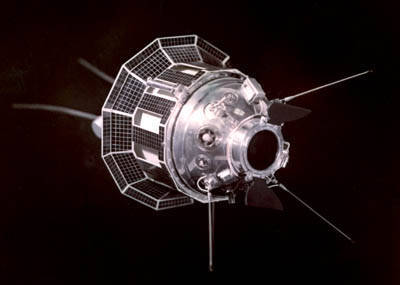E-3 Project
The first proposals were received from Keldysh, and on their basis were selected the main directions in which it was supposed to work. The first project received the E-1 cipher - hitting the surface of the moon, the second - E-2 - circling the moon and photographing its back side, the third - E-3 - assumed to deliver a nuclear charge to the moon. There were other projects, but today I would like to tell only about the E-3 project, as the most exotic and, fortunately, not realized. Why fortunately, it will be clear from the subsequent story.
Like all other projects, the proposal for a nuclear explosion on the moon came from academia. Its author was the famous Soviet nuclear physicist Academician Yakov Borisovich Zeldovich. The main goal of the project is to prove to the whole world that the Soviet station has reached the surface of the moon. Zeldovich reasoned as follows. The station itself is very small and not a single astronomer on earth can detect its fall on the lunar surface. Even if you fill the station with explosives, no one on Earth will notice such an explosion. But if an atomic bomb is blown up on the lunar surface, then the whole world will see it and no one will have any more questions: did the Soviet station hit the moon or not? It was assumed that an atomic explosion on the moon would be accompanied by such a flash of light that it would easily be fixed by all earthly observatories.
Despite the abundance of opponents of such a project, he, like everyone else, was worked out in detail, and in the OKB-1 (design bureau of S.P. Korolev) even made a station layout. Its dimensions and weight were set by the nuclear scientists, who proceeded from the parameters of the then low-power atomic warheads. A container with a charge, like a naval mine, was all stuck with pins of fuses to ensure an explosion at any orientation of the station at the moment of contact with the surface of the Moon.
Further layout of the case, fortunately, did not go. At the discussion stage, quite reasonable questions were posed about the safety of such a launch. No one was taken to guarantee the absolute reliability of the delivery of charge to the moon. If the launch vehicle had crashed on the first or second stages, the container with a nuclear bomb would fall on the territory of the USSR. If the third stage had not worked, the fall could have happened on the territory of other countries. And this would have caused unpleasant international consequences, which they sought to avoid. There could be other options for the consequences. The container could go into orbit around the Earth and get stuck there. And when no one could have fallen on whose heads he could later fall down. The prospect of missing the moon and sending a nuclear bomb on an eternal journey around the sun was also unpleasant.
There was another organizational and political problem. In order for the explosion to be fixed by foreign observatories, it was necessary to inform them in advance about the experiment. And how to do it, no one represented. In those years, any information about space research, apart from triumphant reports, was strenuously concealed from everyone and everything, and here it was necessary for the whole world to trumpet about their nuclear ambitions.
In the end, they decided to abandon the E-3 project. And the first to propose this was the one who initiated it - Academician Zeldovich.

Subsequently, the E-3 index was assigned to the project, which provided for photographing the far side of the Moon with a higher resolution than the Luna-3 station did. Two launches were performed, 15 and 19 on April 1960. Both of them ended in an accident and no more launches were made within the project.
Information